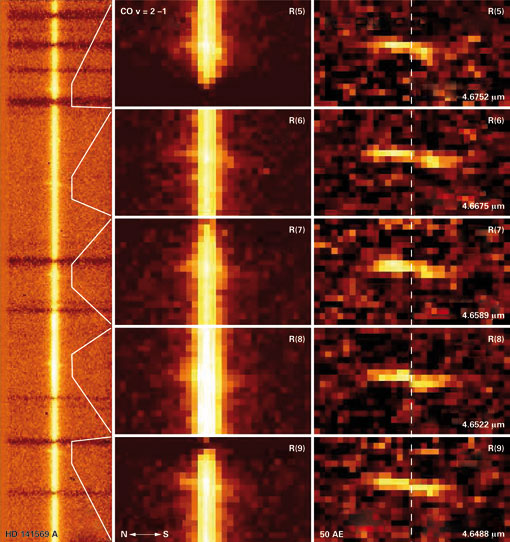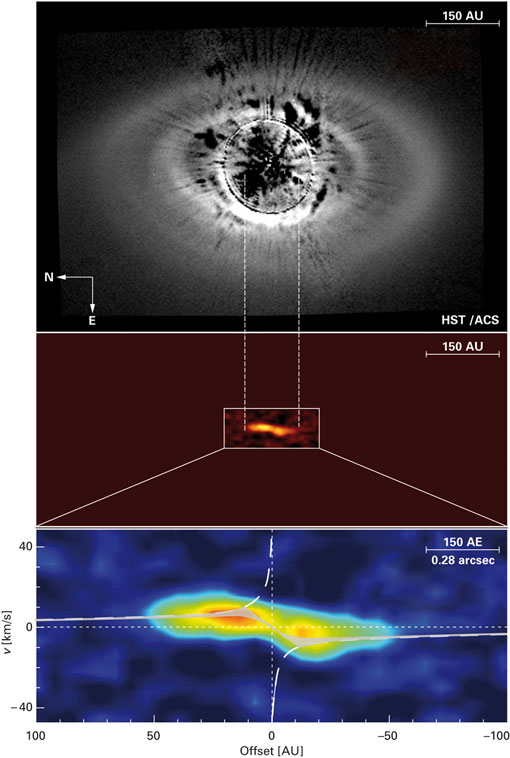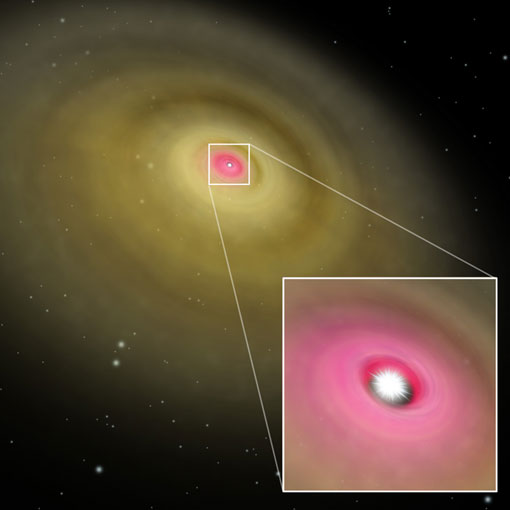| Press Release 06-01-24 The Abrupt End of a Young Circumstellar Disk |
Press Releases 2006 |
Zooming in on a dusty disk around a nearby young star called HD 141569A with the Subaru telescope on Mauna Kea, Hawaii, astronomers from the National Astronomical Observatory of Japan (NAOJ) and the Max Planck Institute for Astronomy (MPIA)have determined the size of the central hole in ist circumstellar disk. The hole's large size, about the size of the orbit of Saturn, supports the theory that a young star ends its infancy abruptly, ionizing and pushing away the gas in the disk from which it was born.
The team, lead by Dr. Miwa Goto and Professor Tomonori Usuda took advantage of the superb spatial resolution attained by the adaptive optics system and the infrared camera and spectrograph (IRCS) on Subaru, to resolve the innermost part of the disk around HD 141569A in emission lines of carbon monoxide in the infrared part of the electromagnetic spectrum. The disk was known to exist from previous studies of the dust around the star. By studying the gas, the new study successfully determined the size of the inner clearing in the disk.
Emission from carbon monoxide (CO) in the disk surrounding HD 141569A, which lies some 320 light-years away from Earth, extends out to a distance fifty times the size of the orbit of Earth. (The distance between Earth and the Sun is called an astronomical unit. In our solar system, the orbital radius of Neptune is about 30 AU). It gradually becomes stronger toward the inner part closest to the star. The emission peaks at around 15 AU, thendiminishes to the central star. »We now know that little gas remains in the inner 11 AU of the disk,« said Usuda. »In other words, HD 141569A has fully developed a hole at the center of its molecular gas disk bigger than the size of the orbit of Saturn.«
»The size of the hole is very significant«, said Goto, "because it limits the possibilities of how the hole came to be in the first place.«
Theoretically, a circumstellar disk could have an inner cavity created by the closure of lines in the star's magnetosphere, which would cut off the disk. This is called magnetospheric truncation and could explain why there is a gap in the dust. However, the size of the truncation has to be much smaller, as small as a hundredth of an astronomical unit, or about the size of the star itself, so this cannot explain the present observation.
The destruction of dust by radiation from the star in a process called sublimation could also produce an inner hole in a disk. Again, the expected radius from such activity is too small, about a tenth of Earth's orbital radius, to account for the central cavity of HD 141569A.
The best explanation for the size of the central cavity of HD 141569A comes from the fact that it corresponds to the gravitational radius of the star. This is the radius where the sound speed of ionized gas streaming from the star is equal to the escape velocity from the star. In other words, the gas outside the gravitational radius can freely escape from the system once it is ionized. The gas in the disk is densest at the gravitational radius and receives more radiation from the central star than the outer part. The mass loss of the disk through photo-evaporation is therefore most efficient at the gravitational radius.
The similar size scale of the inner cavity of HD 141569A's disk and ist gravitational radius, about 18 astronomical units, indicates that the opening is made by photo-evaporation, gas being ionized and pushed away. It also shows that, in general, photo-evaporation is indeed effective in removing a disk from around a young star even if other processes may also be present (such as the piling up of material into clumps called viscous accretion).
This theoretical picture is not new, but the present observation is the first one that offers any clear evidence to support this theory. In this picture, circumstellar disks do not slowly evaporate from regions immediately adjacent to the central star. Instead, a hole as large as the star's gravitational radius appears more or less abruptly, and then grows larger until the disk, and the potential for forming planets, is gone.
The Role of a Circumstellar Disk
A star is born when gas collects within a molecular cloud. The gas is mainly in the form of molecular hydrogen. Because gas has angular momentum, it can't land directly onto the surface of a star. Instead, it forms a thin, disk-like structure around a star, and slowly loses momentum as it orbits the star and so that the star can eventually pull it in. Without such a »circumstellar disk«, a star could not collect mass from its birth cloud.
Beyond its function as the gas supply for star formation, a circumstellar disk also provides raw material for planets. Material left over from the star formation gradually stick together, making pebbles and rocks. These amass together to form even larger bodies, such as 100-meter-wide planetesimals. All of this material continues to rotate around the star while it grows into ever-larger bodies. Eventually, if conditions are right, this accretion process produces a rocky planet similar to Earth.
Recent observational studies of circumstellar disks have been taking advantage of the thermal emission and scattered light from the solid material in disks. However, in the early epochs of a disk's existence, these solids only comprise about one percent of the total disk mass. The rest is still in the gas phase, and mainly in molecular form (like carbon monoxide). Looking at a disk and studying its carbon monoxide component rather than its dust grains, means we are looking at the gas disk, which is the main component of the disk.
A circumstellar disk only exists for a short time while its central star is collecting gas from it. To understand how a disk evolves, imagine that the entire lifetime of the star was only a hundred years. The circumstellar diskwould only exist from three days to a month before it dissipates altogether. A star has only one chance to form a planetary system during the relatively short life of its circumstellar disk. If the ionizing radiation from the star prevents the dust disk from accreting into planets before it dissipates, then the star's chance to become the center of a solar system is lost forever. When and how a disk dissipates, therefore, has direct consequences for the possibility of planetary formation.
These results will be published in the Astrophysical Journal in late 2006 or early 2007 under the title: »Inner Rim of A Molecular Disk Spatially Resolved in Infrared CO Emission Lines«, by M. Goto, T. Usuda, C. P. Dullemond, Th. Henning, H. Linz, B. Stecklum, and H. Suto



Miwa Goto (MPIA)
Tomonori Usuda (Subaru Telescope, NAOJ)
C. P Dullemond (MPIA)
Th. Henning (MPIA)
H. Linz (MPIA)
B. Stecklum (Thüringer Landessternwarte Tautenburg)
Hiroshi Suto (NAOJ)
Die Ergebnisse werden unter dem Titel: »Inner Rim of A Molecular Disk Spatially Resolved in Infrared CO Emission« Ende 2006 oder Anfang 2007 in der Zeitschrift Astrophysical Journal erscheinen.
Further Information:
| Dr. Jakob Staude, | Tel.: 06221 528 229 |
| Dr. Klaus Jäger, | Tel.: 06221 528 379 |
MPI für Astronomie
Königstuhl 17
D-69117 Heidelberg
Pressemitteilungen 2006